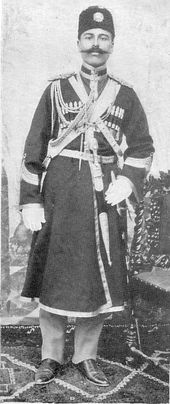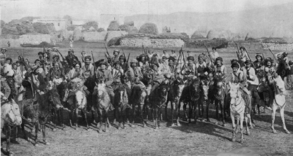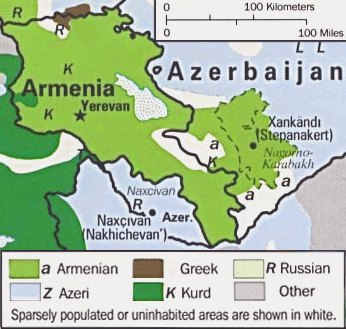Armenian–Kurdish relations


Armenian–Kurdish relations covers the historical relations between the Kurds and the Armenians.
Ancient Armenia and Corduene
Ancient Corduene, identified as Kurdistan in some sources[1] was twice incorporated into the Kingdom of Armenia. The first period was in the first century as a vassal kingdom of Armenia. Corduene was then incorporated in the Roman Republic and remained in Roman hands for more than four centuries. In the late fourth century AD, it became a part of Armenia for the second time (in 384) and remained as such until 428 AD.
Its area was much smaller than what is now called Kurdistan and was mainly concentrated in the south of Lake Van and around Diyarbakir.
Armenians referred to the inhabitants of Corduene as Korduk'. The name found its way into Greek documents and Xenophon used the Hellenized form of the name, Karduchoi (Kαρδoύχoι). According to Strabo, the region of Corduene (Γορδυηνή, also Γoρδυαία όρη "Gordyaean Mts.") referred to the mountains between Diyarbakir and Mush. The term "Karduchoi" is a Greek term and derives from the words "kard-" (καρδιά = heart) and "-uchoi" (-ούχοι = owners). It symbolizes the heart that they had to face their enemies.[2]
Islamic conquest
.jpg)
Kurds and Armenians became increasingly distinct, both culturally and politically, as Armenians chose Christianity as their official religion, Kurds were forced to choose Islam.
Although most Armenians stayed Christian, some converted to Islam because of the status given to Muslims under Turkish rule. The Armenians of Vaspurakan who converted to Islam gradually assimilated into Kurdish culture over time. That is likely to have occurred elsewhere as well, and probably accounts for the comparatively low census of Armenians in the Ottoman Empire at the beginning of the 20th century, compared to the Middle Ages, alongside other factors, such as selective recording, extermination and migration.
Toward the 11th century, the nomadic Turkic tribes from Central Asia moved towards the Middle East and Anatolia and further altered the ethnic mix, at the expense of the local populations of Kurds, Armenians and other natives.
Ottoman Empire
However, Kurds found some degree of friendship in these new immigrants from Central Asia. In some areas of Eastern Turkey, the Kurds and Armenians lived together in the same villages and in other parts, they remained separate.
Until the Russo-Turkish War of 1828–29, there had not been hostile feeling between the Kurds and the Armenians, and as late as 1877–1878, the mountaineers of both ethnic groups had lived fairly well together.[3] Kurds and Armenians lived in peace for many years.
Shaikh Obaidullah, 1880–1881
The Russo-Turkish War of 1877–78 was followed by the attempt of Sheikh Obaidullah in 1880–1881 to found an independent Kurd principality under the protection of Ottoman Empire. The attempt was first encouraged by the Sultan as a reply to the projected creation of an Armenian state, under the suzerainty of Russia. However, it collapsed after Obaidullah's raid into Persia, when various circumstances led the central government to reassert its supreme authority.
Hamidian period

In 1891, the activity of the Armenian Committees induced the Ottoman Porte to strengthen the position of the Kurds by raising a body of irregular cavalry, which was well-armed and called Hamidieh, after the Sultan Abdul Hamid II. Some Kurdish tribal leaders were given high positions. The system of double taxation sparked new found enmity between Turkish chieftains (aga) and the Armenians and Kurds agrarian community who perceived Kurdish taxation as exploitation. When Armenian spokesmen confronted the Turkish aga, it brought about enmity between both populations during which the events at Sason and Moush 1893 occurred.[4]
At the turn of the 20th century, most Armenians were peasants, who were exploited and oppressed by their Turkish feudal beys. According to the Russian vice-consul Tumanskii, Armenian peasants were treated as serfs attached to some Turkish chief. They were sold as property, and if Kurd killed a serf, the latter's master took revenge by killing a serf belonging to the murderer.[5]
Sasun Resistance, 1894
In 1894, the ARF participated in the First Sasun Resistance, supplying arms to the local population to help the people of Sasun defend themselves against the Hamidian purges.[6] Thousands of Armenians were killed by Ottoman troops and Kurdish tribesmen when the Armenians began their struggle for autonomy in 1894.[7] In the summer of 1894, armed Armenian peasants resisted an attack by the Kurds. Then, "Hamidieh" regiments and regular troops from Bitlis and Muş Province, joined by the Fourth Army Corps, were sent to the Armenian regions around Sasun and began a 23-day operation, from August 18 to September 10. The troops massacred at least 8000 Armenians.[8]
Defense of Van, 1896
In June 1896, the Defense of Van in the province of Van was organised while "Hamidieh" regiments were about to attack the city. All ablebodied Armenian men of Van rose with weapons and protected the civilians from attack and subsequent massacre.[9]
Chieftain of Zelian, 1896
The Kurdish chieftain of Zelian, with his army of 3000 to 4000 Kurds, launched an attack on the Armenian villages. The Ottoman governor reported to the Sultan that the Sheikh of Zeilan was being attacked by the Armenians.
Minor disturbances constantly occurred, and were soon followed by the massacre of Armenians at other places in 1894–1896, and Kurds took an active part. They led to the devastation of five Armenian villages and the region of Talori (Dalvorikh). The events at Sason were the beginning of a long series of Armenian demonstrations and their suppression by the Kurds.[2]
Khanasor Expedition, 1897
The Khanasor Expedition was undertaken against the Kurdish Mazrik tribe on July 25, 1897. The Armenian Revolutionary Federation had decided to retaliate, after the Ottoman-hired Mazrik tribe had ambushed and slaughtered a squad of Armenian defenders during the 1896 Defense of Van.
World War I

During the Armenian patriotic movement of the late 19th century, the Ottoman Muslims of Eastern Asia Minor, who happened to be mostly Kurdish and Turkish, were the main enemies of the Armenian patriots. The formation of the Armenian patriotic movement began roughly around the end of the Russo-Turkish War of 1878 and intensified with the introduction of Article 166 of the Ottoman Penal Code and the raid of Erzerum Cathedral. Article 166 was meant to control the possession of arms, but was used to target Armenians by restricting their possession of arms. Some local Kurdish tribes were armed and ordered to attack the Armenians. However, it should also be noted that not all Kurds took part in the killings of Armenians, and many helped Armenians flee the Ottoman Empire.[10] Many Kurdish political figures sheltered Armenians from the Hamadiye corps and Turkish soldiers such as the Kurdish mayor of Khnus.
Turkish War of Independence
In the aftermath of the defeat of the Ottoman Empire in World War I, the Entente Powers proposed to divide up its Anatolian lands in the Treaty of Sèvres. Among other things, the full application of the treaty would have led to the expansion of the Democratic Republic of Armenia to include regions such as Bitlis, Van, Erzurum and Trabzon while granting local autonomy to the Kurdish inhabited areas east of the Euphrates river and to the south of Armenia. Sharif Pasha, the Kurdish representative in the Paris Peace Conference, reached an agreement with the Armenian representatives on December 20, 1919, and both parties made joint declarations to the conference.[2]
However, Turkish revolutionaries led by Mustafa Kemal Atatürk rejected the treaty as "unacceptable" and fought for total control of all of Anatolia in the Turkish War of Independence. The Sèvres treaty was then succeeded and replaced by the Treaty of Lausanne which established, roughly, the present-day borders of the Republic of Turkey (except Hatay). The Lausanne treaty not only dashed any hope of an independent Kurdish state but also did not confer upon the Kurdish people the minority status (and its entailed rights) given to Greeks, Armenians and Jews.
Kurds and Turks were united in the aftermath of World War I against the non-Muslims victors and local Armenian Christians, and Islam was the unifying factor.[11] When due to Atatürk reforms Islam became disentangled from the state, Atatürk undermined the foundations of Turkish-Kurdish unity.[12]
Republic of Ararat
A series of Kurdish rebellions against Turkey throughout the 1920s culminated in the temporary establishment of the Republic of Ararat in 1927, located in the province of Ağrı, near the border of Soviet Armenia. Without recognition or foreign backing, however, the state ended up being defeated by the Turkish government who resumed control over the region. The Ararat movement was led by Xoybûn, a Kurdish political party which held its founding congress in August 1927 in Bihamdun, Lebanon. An Armenian Dashnak leader, Vahan Papazyan, attended the meeting "as a symbol of the alliance between Armenians and Kurds."[13]
PKK
More Kurdish rebellions would occur throughout the region. The most violent were those by the Kurdistan Workers Party (or the PKK) that was founded in 1978. The war between the PKK and the Turkish government, which spanned the 1980s through the 1990s, caused numerous deaths and internally displaced persons on the Kurdish side.
During the Turkey-PKK war, a photograph showing PKK leader Abdullah Öcalan with M. Yohanna, the Syriac Orthodox bishop of Aleppo, was used by two Turkish newspapers Tercüman and Sabah in 1994 to try to prove that Turkey's Armenian community and church were openly supporting and collaborating with the PKK. In May 1994, the newspaper Özgür Ülke (Free Country; the successor of the pro-Kurdish publication Özgür Gündem) released the correct information regarding the photograph and stated that it was taken during an open March 1993 meeting between Yohanna and the PKK, which was covered by the Kurdish news agency Kurdha and the magazine Özgür Halk (Free People). They said that it was found by Turkish security forces during a search in the rooms of the agency Özgür Gündem. The Turkish media also claimed that Armenia was hosting PKK training camps, but the allegations were proven to be untrue.[14]
Some Kurds in a struggle against Turkey began to identify themselves with the Armenians, the very people whom they were encouraged by the Ottoman government to oppress. Today, Turks of Armenian and Kurdish ethnicity coexist in peace. The PKK leadership has recognized the Armenian Genocide and apologized for Kurdish involvement.[15] There have also been seminars held by Armenian and Kurdish groups to discuss both the genocide and Turkey.[16]
PKK–ASALA
The Armenian Secret Army for the Liberation of Armenia (ASALA) was a Marxist–Leninist organization whose primary objective was "to compel the Turkish Government to acknowledge publicly its alleged responsibility for the deaths of 1.5 million Armenians in 1915, pay reparations, and cede territory for an Armenian homeland".[17] PKK and ASALA held a press conference on April 8, 1980 in Sidon which declared their cooperation, that resulted with the Strasbourg, November 9, 1980, and Rome, November 19, 1980 activities of ASALA and PKK cooperation.[18] However, after July 1983, ASALA disappeared in the Lebanese Beqaa Valley where the PKK established its camps. Both ASALA and PKK were rumored to have been brainchildren of a Soviet Armenian KGB officer named Karen Brutents.[19] Since pro-Soviet Armenians had participated in the founding of an anti-Turkish Kurdish party already in 1927, the theories, arguments, propaganda methods and activity structures were time tested.[19]
Kurds in Armenia

During the period of Stalinist ethnic cleansing in 1937, the Kurds of Armenia became victims of forced migrations.[20]
Soviet era
Kurdish culture flourished in Soviet Armenia between the 1930s and 1980s, and Kurds enjoyed substantial state-sponsored cultural support. There was a Kurdish radio broadcast from Yerevan.[21] The pioneers of modern Kurdish literature and culture were mainly Yazidis who were immigrants from Turkey. The famous Kurdish writers in this period include Casimê Celîl, Emînê Evdal, Kurdoev, Arab Shamilov and Jalile Jalil. The renowned Kurdish newspaper Riya Teze, published in Yerevan, is among the oldest Kurdish newspapers. It is the organ of the Kurdish section of the Communist Party of Armenia. Many Armenian literary works were translated into Kurdish by translators such as C. Celîl, H. Cindî, E. Evdal, Q. Murad, N. Esed and T. Murad. The first Kurdish novel was written by Shamilov in 1935.[2]
Kurdish departments in Armenia
In 1969, The Armenian Academy of Sciences founded a Kurdish Studies Department to document and to research all aspects of Kurdish culture but also to study Armenian and Kurdish relations.[22] One of the first Kurdish newspapers was actually established and published in the capital of Armenia, Yerevan. The newspaper was called Riya Teze (Kurdish: The new road). Later on, another Kurdish newspaper was founded called Botan that was published once every two weeks.[23]
Armenian radio station Denge Erivan (The Voice of Yerevan) broadcast in Kurdish for one hour a day, drawing an audience of ethnic Kurds from southeast Turkey. One author writes that he had a childhood friend who was taunted in school for listening to it in the sixties.[23]
Armenia's Yazidi Kurdish minority
According to the 2001 Census, there are about 40,620 Yazidis in Armenia.[24] According to a 2007 U.S. Department of State human rights report, "As in previous years, Yezidi leaders did not complain that police and local authorities subjected their community to discrimination".[25] A high percentage of Yezidi children do not attend school, both due to poverty and a lack of teachers who speak their native language.[26] However, the first ever Yezidi school opened in Armenia in 1920.[27] Due to the ethnic tension created by the war with Azerbaijan, the Yazidi community has renounced its ties with the mostly Muslim Kurds that fled the country and tried to establish itself as a distinct ethnic group. The Yezidis showed great patriotism fighting with Armenians during the Nagorno-Karabakh war, when many died in service.[27]
References
- ↑ Kurds. The Columbia Encyclopedia, Sixth Edition. 2001-07
- 1 2 3 4 "Kurds", E.J. Brill's First Encyclopaedia of Islam, 1913–1936, p. 1133, By M. Th Houtsma Published by BRILL, ISBN 90-04-08265-4, ISBN 978-90-04-08265-6
- ↑ Hertslet, Edward, Sir. The Map of Europe by Treaty, vol. 4. London: Butterworths, 1891, p. 2686.
- ↑ Peter Balakian, The Burning Tigris, "Killing fields".
- ↑ Astourian, Stephan (1990). "The Armenian Genocide: An Interpretation". The History Teacher. 23 (2): 111–160 [p. 122]. JSTOR 494919.
- ↑ Kurdoghlian, Mihran (1996). Hayots Badmoutioun (Armenian History) (in Armenian). Hradaragutiun Azkayin Oosoomnagan Khorhoortee, Athens Greece. pp. 42–48.
- ↑ Armenian massacres, Encyclopædia Britannica
- ↑ Melson, Robert (1982). "A Theoretical Inquiry into the Armenian Massacres of 1894–1896". Comparative Studies in Society and History. 24 (3): 481–509. JSTOR 178512.
- ↑ Ministère des affaires étrangères, op. cit., no. 212. M. P. Cambon, Ambassadeur de la Republique française à Constantinople, ŕ M. Hanotaux, Ministre des affaires étrangères, p. 239; et no. 215 p. 240.
- ↑ "They Can Live in the Desert but Nowhere Else": A History of the Armenian Genocide, p. 322, at Google Books
- ↑ Martin van Bruinessen, Religion in Kurdistan" http://www.hum.uu.nl/medewerkers/m.vanbruinessen/publications/Bruinessen_Religion_in_Kurdistan.pdf
- ↑ Martin van Bruinessen, Religion in Kurdistan" http://www.hum.uu.nl/medewerkers/m.vanbruinessen/publications/Bruinessen_Religion_in_Kurdistan.pdf
- ↑ G. Chaliand, A.R. Ghassemlou, M. Pallis, A People Without A Country, 256 pp., Zed Books, 1992, ISBN 1-85649-194-3, p.54
- ↑ Tessa Hofmann.Armenians in Turkey Today.
- ↑ Recognition of Armenian Genocide by Kurdistan
- ↑ Kurdish and Armenian Genocides Focus of London Seminar, Armenian Forum.
- ↑ "Armenian Secret Army for the Liberation of Armenia (ASALA)". U.S. Department of State. Retrieved 2007-01-26.
- ↑ PKK Relations with Sub-National Terrorist Groups
- 1 2 "Antero Leitzinger (2005) The Roots of Islamic Terrorism: How Communists Helped Fundamentalists" Archived September 27, 2007, at the Wayback Machine.
- ↑ David McDowall, A Modern History of the Kurds, page 492.
- ↑ ""You, too, Armenia Archived May 13, 2006, at the Wayback Machine.," Kurdish Life (No. 10, Spring 1994).
- ↑ Kurdish studies department in Armenia
- 1 2 Leonidas Themistocles Chrysanthopoulos, , Gomidas Institute.
- ↑ National Statistical Service of the Republic of Armenia - 2001 Armenian National Census
- ↑ Country Reports on Human Rights Practices in Armenia
- ↑ U.S. Department of State Report
- 1 2 "Archived copy" (PDF). Archived from the original (PDF) on 2007-07-10. Retrieved 2015-09-19.
Further reading
- Wilson, Lydia (2007-08-06). "The Kurdish Question". Time. Archived from the original on 27 September 2008. Retrieved 2008-09-15.
|section=ignored (help)
